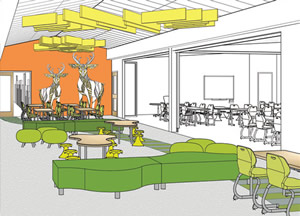Make Green Your Theme
 We have all heard the expression, “If these walls could
talk.” Well, it turns out they can.
And it’s not just walls. Floors, ceilings, windows
and digital displays all have something to say,
thanks to the power of creative interior design
themes. With proper planning and application, a
green theme can be an effective tool for teaching
students about issues related to sustainability and local ecosystems.
We have all heard the expression, “If these walls could
talk.” Well, it turns out they can.
And it’s not just walls. Floors, ceilings, windows
and digital displays all have something to say,
thanks to the power of creative interior design
themes. With proper planning and application, a
green theme can be an effective tool for teaching
students about issues related to sustainability and local ecosystems.
Celebrating Sustainability
What do we mean by a theme? A theme is a unifying interior
design approach that takes its inspiration from a specific topic, such
as nature. The theme is then expressed in multiple ways, including
graphic wall coverings, flooring patterns and digital displays.
For example, at the new West Point Elementary School, located
on the campus of West Point Military Academy, the interior design
theme celebrates the surrounding Hudson River Valley. The five academic
neighborhoods have their own branding based on local wildlife:
deer, raccoons, bears, owls and snakes. The terrazzo flooring
in the main commons mimics the topography of the surrounding
area. In academic corridors, a custom-designed, high impact wall
wainscot gives students the feeling of walking in a grassy meadow.
West Point doesn’t just celebrate nature. Theming elements also
teach students about local history and culture. In the information
commons, a floor-to-ceiling digital display features an interactive
map of the Hudson River Valley. Teachers are able to highlight points
of interest on the map and show how early settlers made their way
through the valley. The display also helps to orient students of military
parents (many of whom travel frequently) to their new home.
The interior design theme at West Point is part of an overall
focus to teach students about their surroundings. Theming supports
and enhances other design strategies, including the using
of cameras to view on-site wildlife and the orientation of building
pathways to lead students to secure outdoor courtyards.
Creating Resilient Themes
The benefit of theming is that it is an effective way to keep sustainability
or other topics top of mind for students and staff. But the
main challenge is identifying a topic that will stand the test of time.
School administrators will change. School curriculum will change.
Occasionally, even a school name will change. So it is important to
develop themes that last. For this reason, themes about nature or science
are ideal. Local history is also a good place to glean inspiration.
After you have identified a theme, make sure your designers focus
on flexible solutions. A vinyl wall covering is easily replaced, a
flooring system is not. If you are establishing a permanent feature,
make it subtle. For example, the terrazzo pattern at West Point is
simple and aesthetically-pleasing. You don’t need to understand its
origins in local topography to appreciate the beauty of the floor.
The adaptability of digital displays makes them an ideal
strategy for unique themes. The same display can teach students
about local ecology, allow them to track the building’s energy use
or simply showcase colorful patterns found in nature.
Making Economical Decisions
Like any design strategy, interior design themes must be evaluated
based on their ROI. The best themes are fully-integrated into the
overall mission of the school and the existing and future curriculum.
Proactive planning is an important part of anticipating the cost of
custom graphics. With modern fabrication methods, manufacturers
can create almost any graphic or image. However, there is a cost premium
for these materials. When planning for theming, make sure
to factor in the extra cost. Also, be selective about where you locate
images and materials. Make a statement in high-traffic spaces like
extended learning areas or commons areas. Using digital displays
will also reduce overall costs, as content is easily modified over time.
Developing an effective interior design theme takes time and
effort, but the results can pay big dividends. If you are looking for
a better way to teach students about sustainability, look no further
than the wall right next to you or the floor underneath your feet.
This article originally appeared in the issue of .
About the Author
Carla Remenschneider, RID, IIDA, is director of interior design for Fanning Howey, a national leader in the planning and design of learning environments.